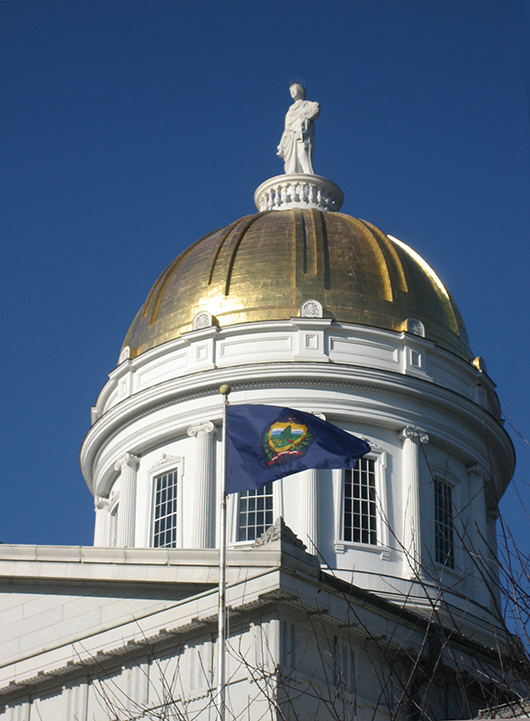
Crews have been working on top of the dome under a tent of plastic, repairing rotted sections and repainting the roughly 15-foot-high sculpture.
The $18,000 project is expected to be finished by next month, weather permitting, said Tricia Harper, the state’s architect.
The hand-carved piece replaced an original sculpture called Agriculture by sculptor Larkin Mead that had rotted. In 1938, during the Great Depression, the 87-year-old sergeant at arms, Dwight Dwinell, took on the task of whittling the head, and the custodial staff carved the body of the folk-art piece.
“The resulting copy was not a very faithful replica of Mead’s work of fine art but is now appreciated as an outstanding example of Vermont folk art,” said Statehouse Curator David Schutz.
The original 14-foot statue was approved by the commissioners overseeing the reconstruction of the Statehouse in January 1858, Schutz said. They picked the simplest proposals from sketches Mead had submitted, including some that incorporated other symbols of farming, such as a plow and animals, he said.
Schutz speculates that the most engaged commissioner, George Perkins Marsh, may have chosen the agriculture theme, referring to the piece as an allegory rather than a goddess, as the statue eventually became known.
“An early rendering of the proposed Statehouse shows the figure of Freedom on top of the dome, so eventually Agriculture prevailed,” Schutz said.
Crews from Liszt Historical Restoration, of Essex Junction, have removed the peeling, cracked paint of the sculpture, replaced rotten portions, and sanded and prepped it for painting. This week they added an elastomeric paint, which allows moisture vapor to exit the sculpture but doesn’t let in water. A second coating was mixed with sand for texture.
They are also doing repairs to some of the balusters in the roughly 5-foot railing that surrounds the base. They will install some vents by drilling small holes in the back of the sculpture — on the north side, which doesn’t see much sun and tends to rot. The small holes will allow moisture to escape, reducing the chance of rot.
Paul List, owner of Liszt Historical Restoration _ which uses a different spelling of the family name — says he’s talking with the state about more frequent maintenance to keep the sculpture in solid shape. It moves a bit in high winds.
“You’ll seal the cracks and just ongoing stuff,” he said, “so you don’t wind up having to do a full-scale restoration all the time.”
# # #
Copyright 2013 Associated Press. All rights reserved. This material may not be published, broadcast, rewritten, or redistributed.
ADDITIONAL IMAGE OF NOTE


